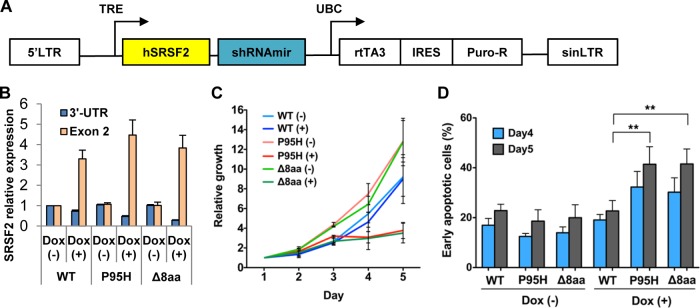FIG 6.

Inducible low-level expression of mutant SRSF2 causes apoptosis and growth arrest. (A) Structure of pTRIPZ-SRSF2 constructs. Expression of microRNA-adapted shRNA for endogenous SRSF2 (shRNAmir) and cDNA of shRNA-resistant WT or mutant human SRSF2 (hSRSF2) is driven by a tetracycline-inducible promoter (TRE). LTR, long terminal repeat; UBC, human ubiquitin C promoter; rtTA3, reverse tetracycline transactivator 3; IRES, internal ribosome entry site; Puro-R, puromycin-resistant gene; sinLTR, self-inactivating long terminal repeat. (B) Quantitative RT-PCR of SRSF2. The samples were measured in duplicate and normalized to GAPDH. Expression in untreated WT cells was set to 1. 3′-UTR, endogenous SRSF2 expression; Exon 2, exon 2 coding sequence, representing total SRSF2 expression. (C) Growth curves. Cells were seeded in triplicate in four independent experiments and counted using trypan blue. Dox-treated (+) P95H and Δ8aa cells showed significant growth suppression compared to other groups. (D) Apoptosis assay. Cells were seeded in duplicate in four independent experiments. Early apoptotic cells are defined as annexin V+ 7AAD− cells. Dox-treated P95H and Δ8aa cells showed significantly enhanced apoptosis compared to other groups. **, P < 0.005.
